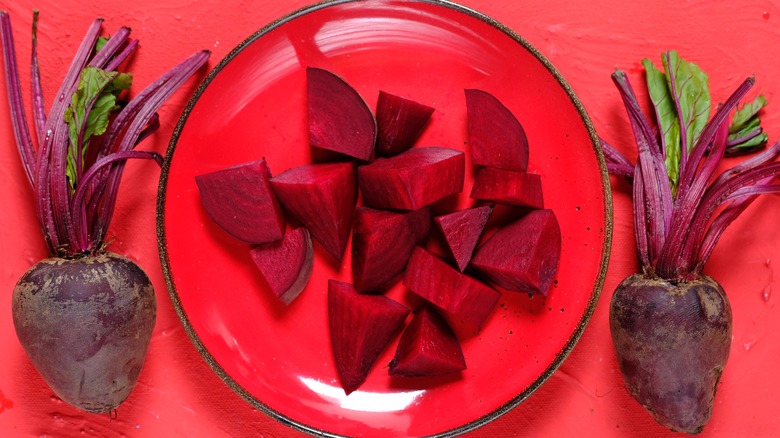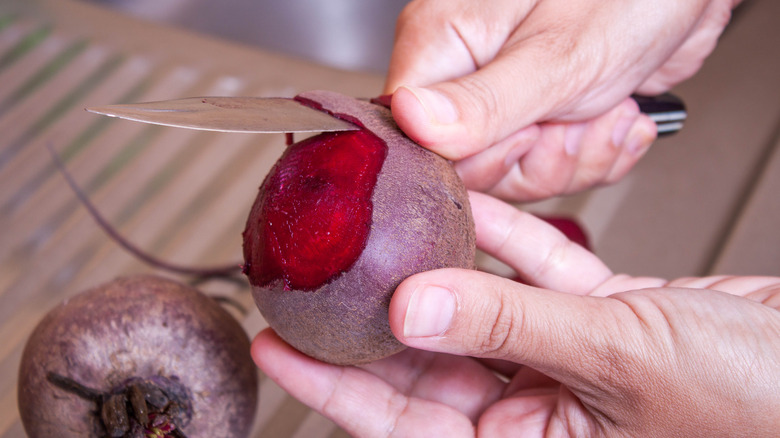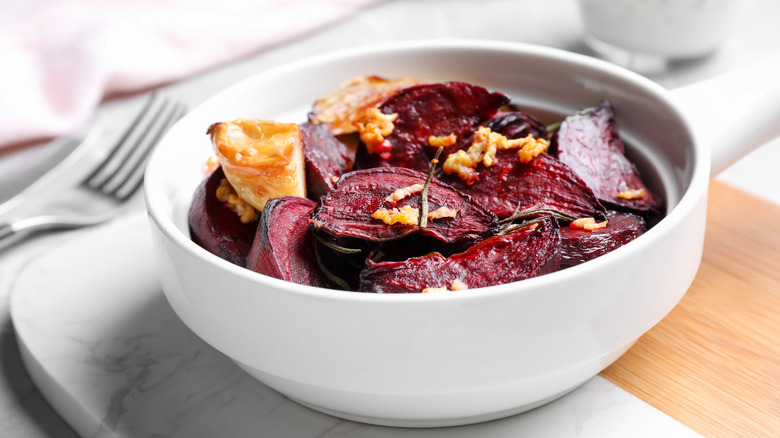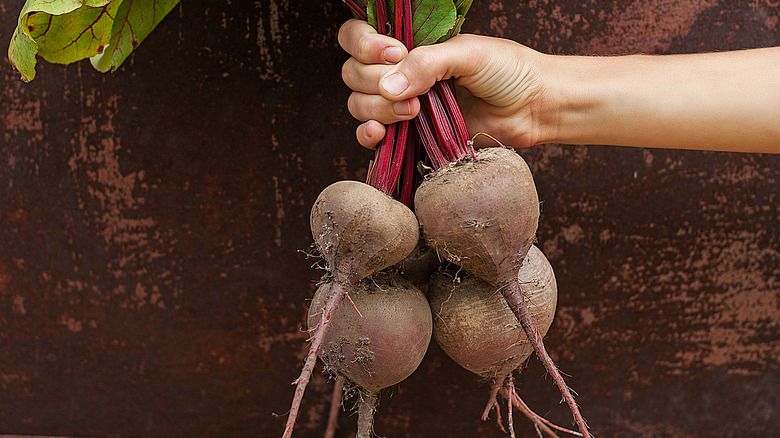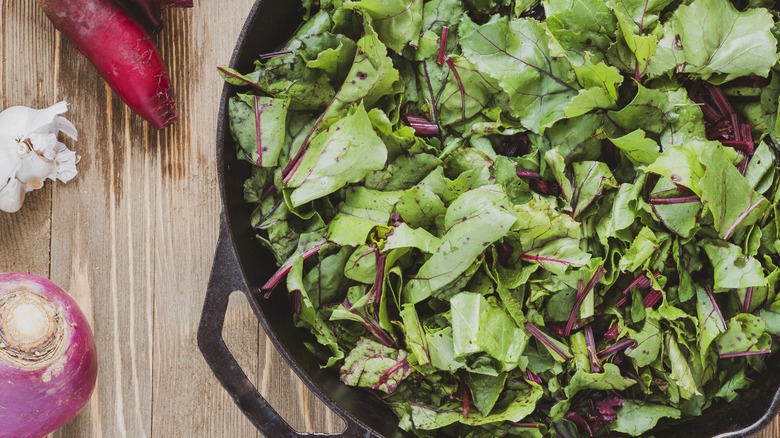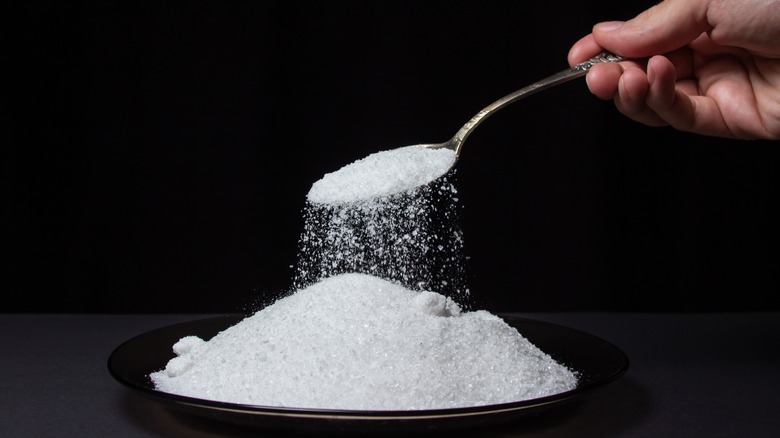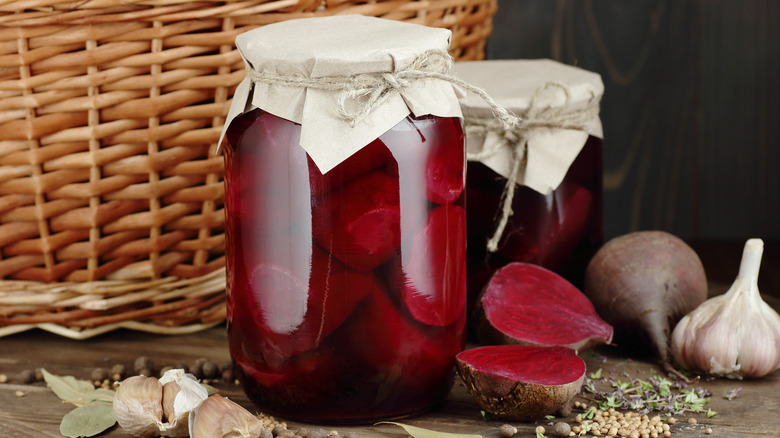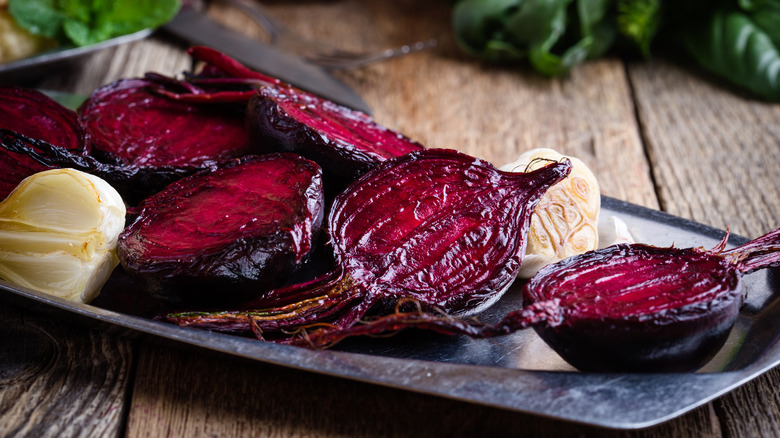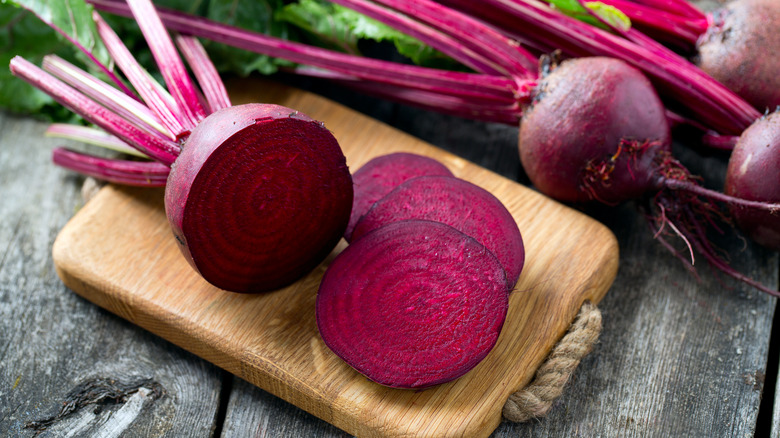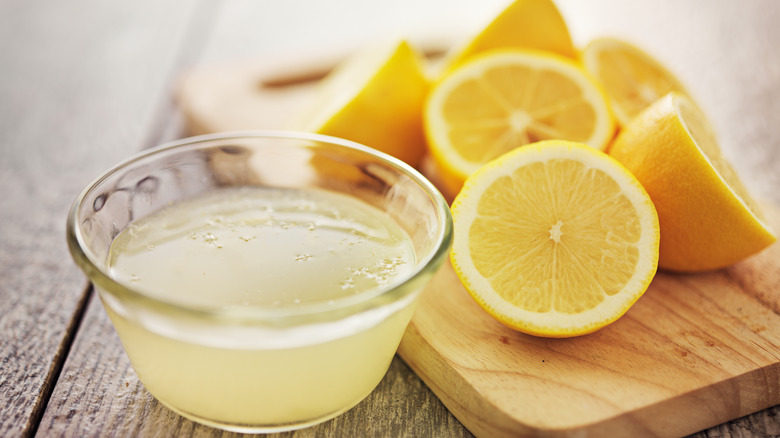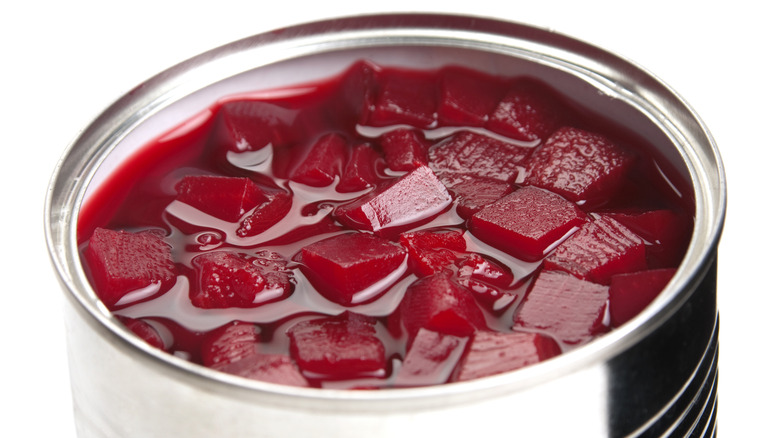14 Mistakes People Tend To Make When Preparing Beets
While other vegetables have fresh, sharp tastes and vibrant colors, few are as striking or unique as beets. This root vegetable, called beetroot in the United Kingdom, is actually related to quinoa, although you might not know it from how it looks on your plate. Appearing as a round, red or brown bulb when unpeeled, beets become a festival of flavor and color once prepared, with a striking, ruby-red flesh and a sprightly, tangy taste. While they can be pretty divisive (with none other than Barack Obama and his family hating them), there's no denying that they're good for you, full of antioxidants, fiber, and vitamins.
Unfortunately, though, beets are not the easiest vegetable to prepare in the world. Perhaps because they're a love-them-or-hate-them kind of food, there's arguably less info out there on how to get them just right. As a result, it is prone to be done incorrectly, with cooks around the world making simple mistakes that could be easily avoided. Well, we're here to put a stop to all those errors. With our guide, you'll be able to sidestep all the pitfalls that occur when making beets.
Not protecting your hands and cookware
One of the main problems people face when preparing beets is because of their shock-red color. Beets' deep red flesh and juice, which is a large part of their appeal, is also highly prone to staining pretty much everything it comes into contact with. Although this can be a good thing if you're using them to tie dye some old t-shirts, it's not great if you're trying to get them onto your plate without making your whole kitchen look like a crime scene.
To get around this common issue, you need to plan ahead. Beet juice has a tendency to work its way into porous materials, so when chopping them, use a cutting board made of non-porous material. Glass cutting boards are a great choice, as they can be wiped clean after use. Another absorbent surface is, of course, your skin. So, if you want to avoid having awkwardly stained hands for hours afterward, pop on a pair of rubber gloves. If your hands do become stained, never fear — all you need to do is scrub them with a little baking soda and water, and that should lift the marks right out.
Peeling your beets
Think of beets, and most people think of solid-red chunks or strips, adding a serious shot of color to a salad. But one of the biggest mistakes you might be making is getting rid of the skin on your beets, which not only adds extra hue variation, but nutritional value too.
Contrary to popular belief, you don't have to peel your beets at all. Beet skin is entirely edible and contains some of the densest nutrition in the vegetable. Removing it specifically takes away the betalain pigments from the plant, compounds which have been found to have anti-inflammatory, anti-cancer, and brain-boosting qualities, as a review published in the journal Plants states.
There are, however, reasons that you'd want to peel your beets. They have a different texture from the interior of the plant, and if you're looking for a uniform color and mouthfeel, it could be worth removing them, as beet flesh is still pretty nutritious. Beet skin can also carry dirt and grit from its growing process, although this can often be eliminated by scrubbing the plant with a hard-bristled brush. If you're preparing raw beets, it might be simpler to remove the skin after they're cooked, as it tends to get soft enough to be able to simply slip off.
Forgetting your flavorings
If there's one thing beets aren't, it's shy. When they're cooked, they have a pronounced, bold taste, with sweetness and earthiness that separates them from other, more subtle vegetables. But just because beets are confident on their own, doesn't mean you shouldn't try and jazz them up with other flavors.
Because of their pronounced taste, beets do especially well with lighter accompaniments that boost their flavor, with herbs being a great pairing. Basil and dill are two great options to freshen up the vegetable. The former has a slightly sweet edge that brings out the beets' natural sugars, whereas the latter has a gently earthy, yet floral taste, which plays to the mellower flavors in the root veggie. Mint is another classic choice to go with beets, bringing both a zing and an earthiness that develops the dish you're making brilliantly.
Beets also benefit hugely from the addition of acids, which cut through their density. For this reason, a spritz of lemon or lime juice is a superb way to lighten them up and stop them from becoming too heavy.
Starting with beets that are past their prime
Beets are a hardier vegetable than most. And while leafy plants like spinach or lettuce might show you visible cues when they're starting to go bad, this stout root may not make things so clear. So, avoid any problems when you get home from the store; you'll want to be on the lookout when you're buying beets, to make sure they're the freshest ones possible.
The first thing you're looking for with fresh beets is a uniform color. Its leaves, if they're still attached, should be green and verdant, and its skin unbruised and unblemished. The skin should also look and feel firm, with no softness, shriveling, or dents anywhere on the plant.
Bad beets, on the other hand, will appear soft, bumpy, or wilted, and should be avoided. If you pick beets that have started to turn bad, you run the risk of getting a result that's too mushy, strange-tasting, or else too tough, making it difficult to cook. If you're in any doubt about whether beets are fresh or not, it's best to skip them in favor of others.
Throwing away your canned beet juice
Not all of us have the time, or the inclination, to prepare beets from scratch. And that's okay. Canned beets are a simple, easy choice for when you need your beet fix. Whether you're canning them yourself or buying them in the store, canned beets retain their structure well, remain nutritious, and most importantly, don't need much preparation to get onto your plate.
But too many of us are familiar with opening up a can of beets (or, indeed, any vegetable), and draining out the seemingly endless juice inside. Before you pour away that red-purple elixir, remember that it's super useful. Beet juice can be utilized in a range of other recipes, from your afternoon beet smoothie to your red velvet cakes (provided that the juice isn't salted, that is).
Juice from canned beets is also terrific if you're using the beets to make borscht. The juice will amp up the soup's flavor and bulk out its content, and you'll retain all of the nutrients that have seeped from the vegetable into the water surrounding it.
Not keeping your greens
Beets are primarily prized for their dense, red-purple roots, with the bulbous part of it containing a meaty flesh. But like all root vegetables, that's just one element of the entire plant. And the greens that stem from the root have a culinary use of their own, which way too many people forget.
Beet greens have robust, sizeable leaves, held together by red stalks, the color similar to the shade of the root's flesh. They're similar in hardiness and taste to other green leaf vegetables, like chard or collard greens, and as such can be used in many of the same ways. Instead of tossing them out, they can be eaten on their own, and are delicious steamed, with seasonings and butter stirred through. Like kale and spinach, they can also be used in pasta or salads.
Just make sure that you're storing them properly, to ensure their freshness when you eventually eat them. Usefully, beet greens are prepared for storage in pretty much the same way you would any other green. Just wash them to remove any dirt, pat them dry, and store them in some fresh paper towels to keep them crisp.
Forgetting to blanch your canned beets
Fresh beets are a total delight, but for the unfamiliar, they can be daunting. Not only can the preparation be a little lengthy, but you're always running the risk of getting beet juice all over your surfaces and skin. That's why, for many people, canned beets are the answer, allowing you to enjoy beets any time you want. But using any processed foods over fresh ones comes with compromises, and for beets in metal cans, that compromise could be an unpleasant metallic taste seeping into the vegetable from its container.
To avoid this meal-ruining mishap, all you need to do is blanch your canned beets. Blanching canned vegetables can strip away any residual metal tastes from your food, and leave you with beets that taste like you made them yourself. Just drain the beets, keeping the juice for use in smoothies or soups, and then put them in a pot of boiling water. Let them bubble away for a minute or two, and then take them out, and shock them in cold water. Your beets will taste fresh and sprightly. Just ensure that you don't cook them for too long, as you don't want them to turn to mush.
Not adding salt when you cook them
One of the main selling points of beets is their one-of-a-kind flavor, a combination of earthy, dense undertones and sweet top notes. But pretty much all vegetables are made better by the addition of salt, and beets are no exception.
With beets, though, the salting starts a little earlier. It's important to add salt to the water you're boiling them in, ideally around a teaspoon of salt for every three to four whole beets you're cooking. The reason you add salt at this point is that it can work its way into the vegetable while it's cooking, which just makes it taste better. As well as this, adding salt to water changes its chemical properties, meaning that it boils quicker — which could speed up your cooking time.
If you don't want (or just forget) to add salt to your boiling water, though, never fear. You can still sprinkle it on top of the vegetable after it's cooked. Bear in mind, though, that this will probably give you a less consistent flavor throughout. Additionally, if you're using canned beets, they may well have sodium added already. So, keep an eye on how much salt you're adding, and do a taste test before.
Only using fresh beets
It's easy to get pretty strict about just using fresh foods instead of canned ones. And we can understand why. Generally speaking, fresh vegetables are usually going to be the best choice in terms of nutrition and, well, freshness. But fresh beets can be slightly less common than other root vegetables like carrots and potatoes, and frankly, they can be tricky to find sometimes.
And when your supermarket is out of fresh beets, don't avoid them entirely — just grab some canned beets instead. They're not just quicker and arguably simpler than using fresh beets, but they're also pretty nutritionally sound, with much of the healthy properties retained in the vegetable. Like their fresh counterparts, canned beets are full of essential vitamins and minerals like magnesium, potassium, folate, and vitamin C, among others. They're also just as versatile, and as they require no cooking, can go straight into your salads or Buddha bowls. And, as with other canned foods, they'll last way longer than the fresh version, so you can stock up and use them whenever you choose.
Preparing them just one way
It's easy to get stuck in a rut. And for some reason, when it comes to certain vegetables, we can tend to prepare them just one way. We steam our broccoli, grill our carrots, and serve our cherry tomatoes raw. Beets can suffer from a similar type of repetition, with boiling a common way to prepare them. This lack of variety, though, is a terrible mistake that causes all too many people to not enjoy the full flavor diversity of this vegetable.
So, next time you get fresh beets from the market, mix it up. Classic roasted beets are an easy and super-tasty side dish that requires barely any effort. Just wash and trim the beets, place them in a deep sheet pan, and drizzle on some oil, salt, and pepper. Put them in a 350-degree oven for about an hour or so, and then remove and serve. If you like, you can also add in additional seasonings, or slice them into rounds, which allows them to brown, develops their flavor, and reduces the cooking time. Grilled beets are similarly simple, with the vegetable thrown on the grill, which allows them to get a charred, deep flavor.
Thinking they need throwing out
The wheel of time keeps turning, and nothing lasts forever (apologies for getting all existential on you there, but it's true). And beets, like all other foods, go off eventually and will need to be thrown out. But for those unfamiliar with beets, a classic mistake is to think they're past their prime way before they actually are.
Luckily, root vegetables like beets tend to last longer than other, more delicate plants like lettuce or avocado. Beets can generally be stored for around 7-10 days and remain fresh, and in some cases can last longer than that. If you freeze them, they'll last even longer and can be thawed and eaten for up to 10 months after doing so.
To optimize these timespans, though, take note of how best to store them. Fresh beets should be kept in cooler, darker conditions, ideally in your fridge's vegetable drawer. Placing them in a resealable plastic bag may also help to keep them fresh and separate them from other vegetables. To freeze beets, you'll need to cook them beforehand, then dice them into smaller pieces and place them in a freezer container or bag.
Only using beets for savory recipes
One of our favorite things in the world is finding new uses for classic foods. And just like it can be easy to fall into a rut with how you cook your beets, it can also be easy to use them in exactly the same way every time. Well, not anymore. Beets are just as good in sweet recipes as they are in savory salads or stews, thanks to their inherent sweetness, as well as the ruby tones they can give desserts. Furthermore, it's a great way to get some additional nutrients into cakes and candies.
And luckily, there are many methods to use beets in your sweets. One of our favorites is to use beets as part of a red velvet cake, harnessing their taste, color, and texture to deliver a dream dessert. Beetroot sorbet is also a classy way to use leftover beets by pureeing them down and mixing them with other fruits for an earthy-sweet dish that's the ideal ending to a meal. Beet puree can be mixed into a range of other desserts, too, adding a depth of flavor and a kick of vitamins and minerals.
Forgetting about the acid
Anyone who's tried beets before will know how dense they are. Somewhat similar to potatoes in texture, these vegetables pack some bulk onto any plate. And just as potatoes can be brightened up by a spritz of lemon juice or malt vinegar (fish and chips, anybody?), beets benefit from the addition of some acid. Adding vinegar or lemon-lime juice to beets can help to offset their earthy flavor, and puts a spring in the step of the red vegetable, pairing well with its slightly sugary edge.
And there's one other key reason you should be using acid with your beets: their color. Beets are largely given their red shade by betanin molecules. When the pH levels of any liquid that surrounds betanins are lower (and remember, the lower a pH level is, the more acidic things are), they're more likely to retain their redness, keeping everything looking fresh and vibrant. And the best way to lower the pH of things is with a few tablespoons of lemon juice or white distilled vinegar. It's a feast for your eyes as well as your stomach.
Using canned beets that are too old
As anyone who's ever had to prep for a hurricane or watched a zombie movie will know well, canned foods last a long time. But this apocalypse-friendly method of storing grub isn't foolproof. And while canned beets, and other canned vegetables, will last longer than their fresh siblings, it's useful to remember that sooner or later, they'll need to be disposed of.
If your beets were canned in a jar, you generally have around a year to 18 months before they become inedible and unsafe. This is, of course, provided that they haven't been opened in that period and that they were canned correctly using a pressure canner. Beets canned in metal in a factory will last significantly longer, and you may be able to eat them beyond their printed expiration date. If kept in a cool, dark place, they might be edible for up to five years after you buy them. Remember, though, that any damage to the can may shorten this significantly. So, if your can has any perforations or rust, is misshapen, or if the beets inside look like they're an off color or texture, it's best to use a different can instead.
